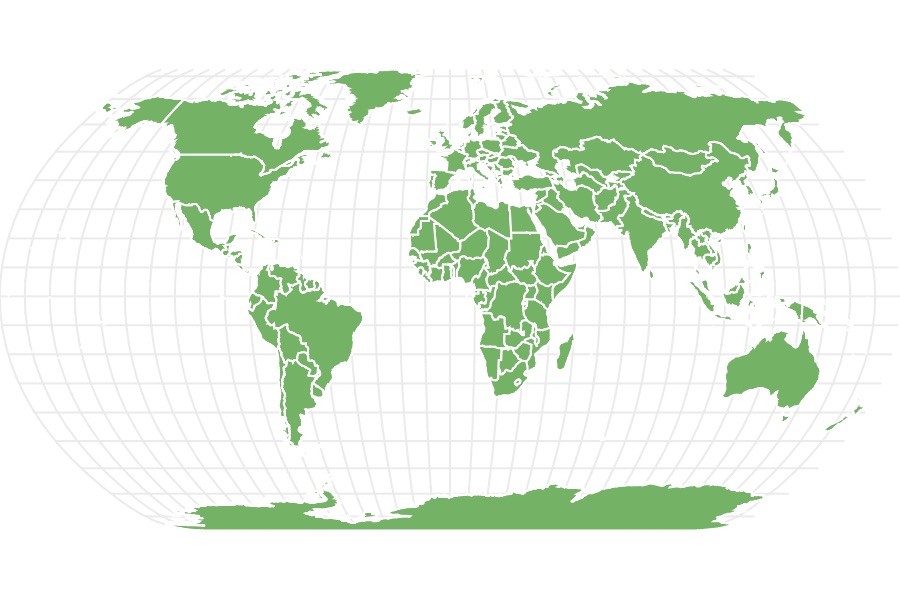Babirusa
Babyrousa spp.
The babirusa is the only mammal with vertically growing canine teeth!
Advertisement
Babirusa Scientific Classification
- Kingdom
- Animalia
- Phylum
- Chordata
- Class
- Mammalia
- Order
- Artiodactyla
- Family
- Suidae
- Genus
- Babyrousa
- Scientific Name
- Babyrousa spp.
Read our Complete Guide to Classification of Animals.
Babirusa Conservation Status
Babirusa Facts
- Name Of Young
- Piglet
- Group Behavior
- Solitary/Group
- Fun Fact
- The babirusa is the only mammal with vertically growing canine teeth!
- Biggest Threat
- Habitat loss
- Most Distinctive Feature
- Curved tusks on the upper half of its snout
- Other Name(s)
- Deer-pig
- Gestation Period
- 155-158 days
- Litter Size
- 1-2
- Habitat
- Swamps, forests near rivers
- Diet
- Omnivore
- Favorite Food
- Berries, leaves, fruit, insects, carrion, fungi, bark, grasses
- Type
- Mammal
- Common Name
- Babirusa
- Number Of Species
- 3
- Location
- Indonesia
- Group
- Social and solitary
Babirusa Physical Characteristics
- Color
- Brown
- Grey
- Skin Type
- Hair
- Top Speed
- 30 mph
- Lifespan
- 10 years
- Weight
- 200-220 lbs
- Height
- 2-3 ft
- Length
- 3-3.5 ft
- Age of Sexual Maturity
- 2 years
- Age of Weaning
- 6-8 months
View all of the Babirusa images!
Babirusas can stand up on their back hooves to reach leaves on low branches in trees.
Babirusas are known for their unique, curving tusks that are in fact teeth and give them a more prehistoric appearance than many modern animals. They are referred to as deer-pigs due to their resemblance to large pigs and tusks like a deer‘s antlers. These omnivores eat plants, fruits, berries, insects, and carrion. The babirusa is found on the Sulawesi, Sula, Buru, and Togian islands in Indonesia.
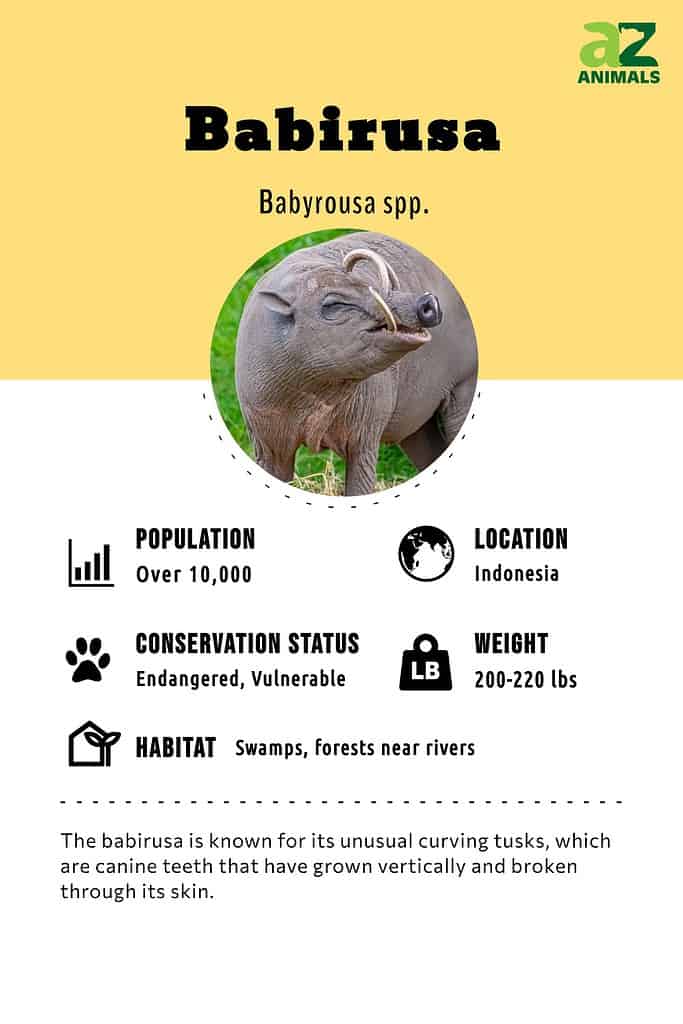
4 Incredible Babirusa Facts!
- The tusks on the upper snout of this animal are actually canine teeth that have grown up and broken through the skin.
- These mammals communicate with one another by grunting, growling, and chattering their teeth.
- Scientists are not certain about the true purpose of a male babirusa’s tusks.
- Cave paintings of babirusas thought to be 35,400 years old were found on the island of Sulawesi.
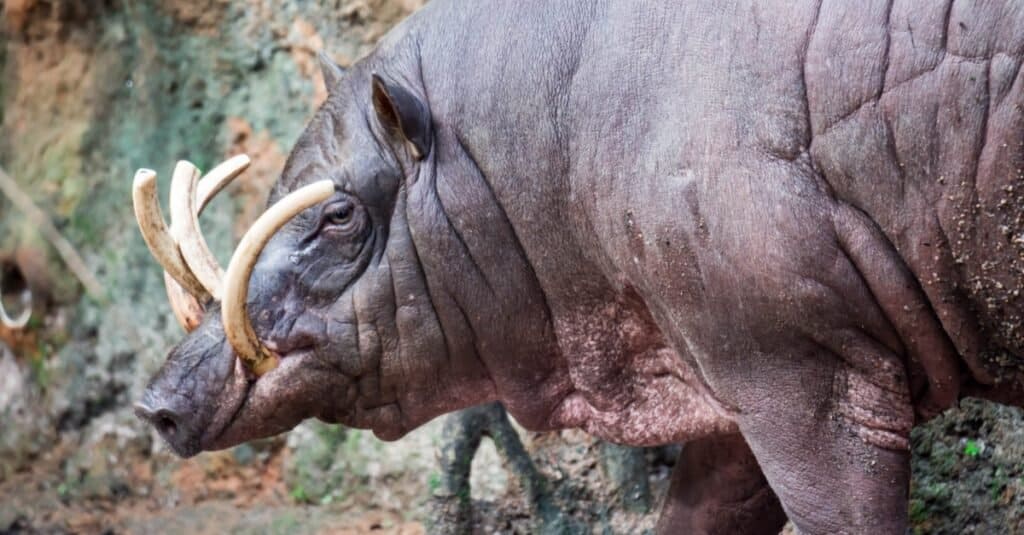
Scientists are uncertain how the babirusa’s tusks evolved and their purpose.
©Bill Roque/Shutterstock.com
Scientific Name
The babirusa belongs to the genus Babyrousa. Previously, all the members of the genus were thought to be the one species, Babyrousa babyrussa, but when morphological and genetic differences were discovered in 2002, the genus split into separate species.
They belong to the Suidae family. The Malaysian word “babirusa” translates to deer-pig.
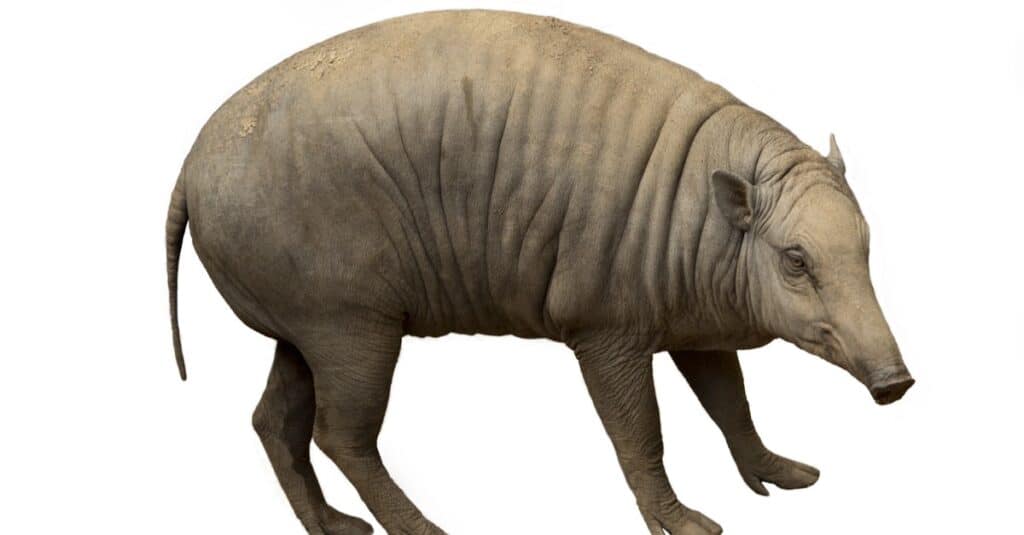
The babirusa’s genus is
Babyrousa.
©Podolnaya Elena/Shutterstock.com
Types of Babirusa
There are three widely recognized species of babirusas that differ in the size of their bodies, teeth, and skull, as well as the amount of hair on their body and tail tuft. They are:
- North Sulawesi babirusa (Babyrousa celebensis): Also known as the Sulawesi babirusa due to their presence in the Sulawesi island and its neighboring islands Buton, Muna, and Lembeh, this species is probably the best-known of the babirusas. It has gray skin, and unlike the Buru babirusa it does not have hair on its body or tail tuft. Measuring around 85-110 cm (2.7-3.6 ft) in length and about 100 kg (220 lbs) in weight, it is smaller than the Togian babirusa. There is a sizable population in captivity.
- Buru babirusa (Babyrousa babyrussa): Called the hairy or golden babirusa, this species has golden-brown fur that is long and thick and a notable tail tuft. Its habitats are in the Indonesian islands of Buru, Taliabu, and Mangole.
- Togian babirusa (Babyrousa togeanensis): Located only on the Togian Islands, this species has shorter and thinner upper teeth than the North Sulawesi Babirusa. Their tusks always converge and they have a larger tail tuft.
There is another possible species under consideration: the Bola batu babirusa (Babyrousa bolabatuensis). This proposed species is found in Sulawesi and is currently classed as a North Sulawesi babirusa. The IUCN does not recognize it and more research is needed to determine whether it should be a distinct species.
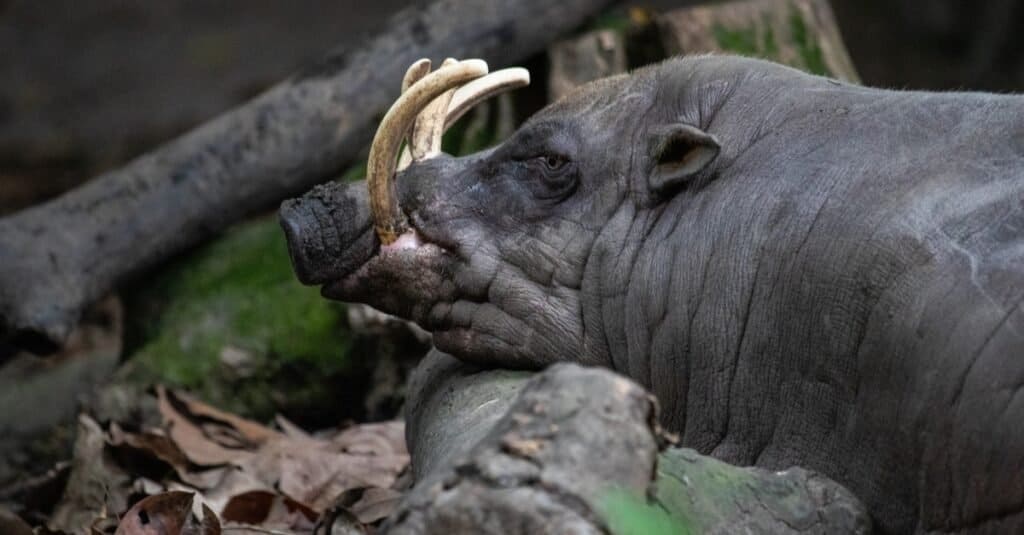
The species of babirusa vary in size, amount of hair, and teeth measurements.
©tomava/Shutterstock.com
Evolution and Origins
The babirusa’s evolutionary history has been a subject of fascination for years for scientists since 1854, when explorer and naturalist Alfred Russel Wallace first began documenting the area in southeast Asia that was named after him and described this pig-like animal.
While much is still unknown about the babirusa’s history, based on fossil evidence there were thought to be two extinct subspecies prior to the 2002 taxonomic division. One extinct subspecies from southwestern Sulawesi, B. babyrussa beruensis, was traced back to the Pleistocene epoch of 2.58 million years ago to 11,700 years ago and was larger than the modern babirusa. The other extinct subspecies, B. babyrussa bolabatuensis, from the south-eastern region of Sulawesi was present in the Holocene period, 11,700 years to the present.
Other early evidence of babirusas are prehistoric paintings of the animals discovered in Sulawesi caves that are believed to have been created at least 35,400 years ago, sometime in the Pleistocene.
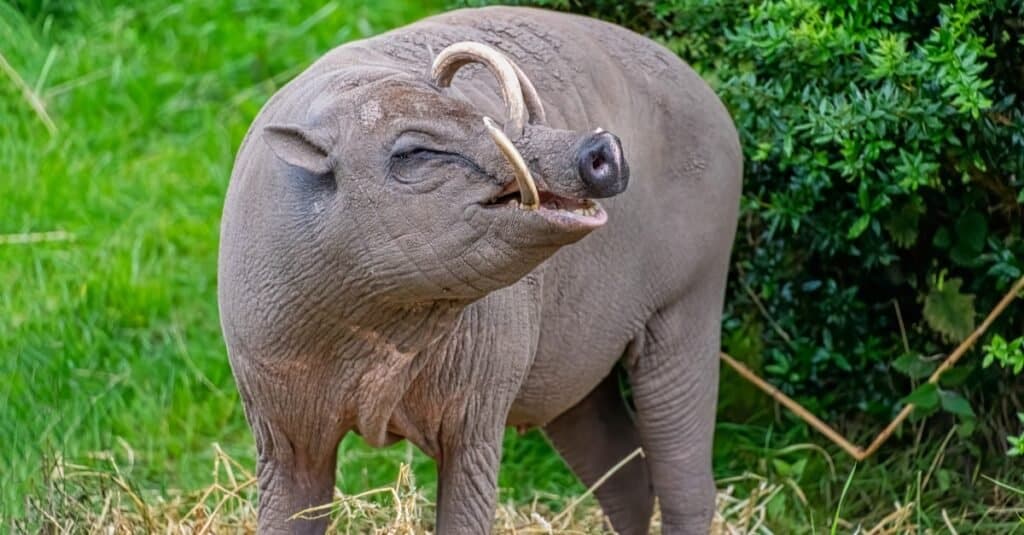
It’s thought that the babirusa’s lineage can be traced back to the Pleistocene epoch.
©Craig Russell/Shutterstock.com
Appearance and Behavior
Babirusas have brown or grayish-colored skin with little body hair. Due to the length and rounded shape of their bodies, they have been likened to torpedos. Their legs are thin like those of a deer.
These animals can grow to reach 2-3 feet, 3-3.5 feet long, and weigh around 132-220 pounds, with the North Sulawesi babirusa the heaviest. A babirusa that is 3 feet tall would be about as high as 2.5 bowling pins stacked. One that is 220 pounds would weigh around the same as an adult panda bear.
The most well-known feature of this mammal is its tusks. It has two tusks on the lower half of its snout and two on the upper half. Though they are called tusks, they are actually canine teeth. On its upper snout, the babirusa’s canine teeth grow, break through the skin, and curve upward and back toward the babirusa’s eyes. In fact, these curving teeth can grow so long, there is evidence that they can actually penetrate the skull of this animal and cause death.
Their lower canine teeth grow sideways and upward out of the babirusa’s mouth. Only male Sulawesi babirusas have full-sized tusks on the upper half of their snout. Females may have very small, short upper tusks or none at all. However, both males and females have tusks on the lower half of their snouts.
Babirusas have four-pointed, strong hooves that they use to dig. They dig up insects, insect larvae, plants, and roots. Also, when two males are fighting in competition for a female, the males use their hooves to strike each other. They rear up on their back feet, smashing into each other, kicking their hooves. It is a fierce and noisy competition!
Humans and feral, or wild, dogs are the only predators of adults. These mammals can run at speeds of up to 30mph. So, when they encounter a human or a feral dog, these shy mammals run and hide in a swampy area or rainforest. Their dark skin allows them to blend in with their muddy, swamp habitat.
Most males are solitary. Alternatively, females are social creatures living in groups of 80 or more babirusas. This large group includes only females and young babirusas.

Male babirusas will compete over a female during the breeding season.
©JPL Designs/Shutterstock.com
Habitat
Babirusas live on islands in Indonesia including Togian, Sula, Buru, and Sulawesi. Wild babirusas don’t live anywhere else in the world except on these islands. These mammals live in a moist, tropical climate in swamps and in rainforests, near rivers. They take shelter in the underbrush and in canebrakes.
These swine roll around in the mud in order to cool themselves in this humid climate. This is also an effective way to get rid of any parasites on their skin. Another interesting behavior of these animals is called plowing. A male babirusa lowers itself to its knees and pushes its nose through the sandy ground. The babirusa has its mouth open and takes in the sand while releasing foaming saliva. This is strange behavior that scientists haven’t fully figured out. But they think plowing may be a way for a babirusa to mark its territory with its scent.
In addition, these animals are great swimmers so they tend to live near rivers. They’ve been known to swim a long distance from one island to another.
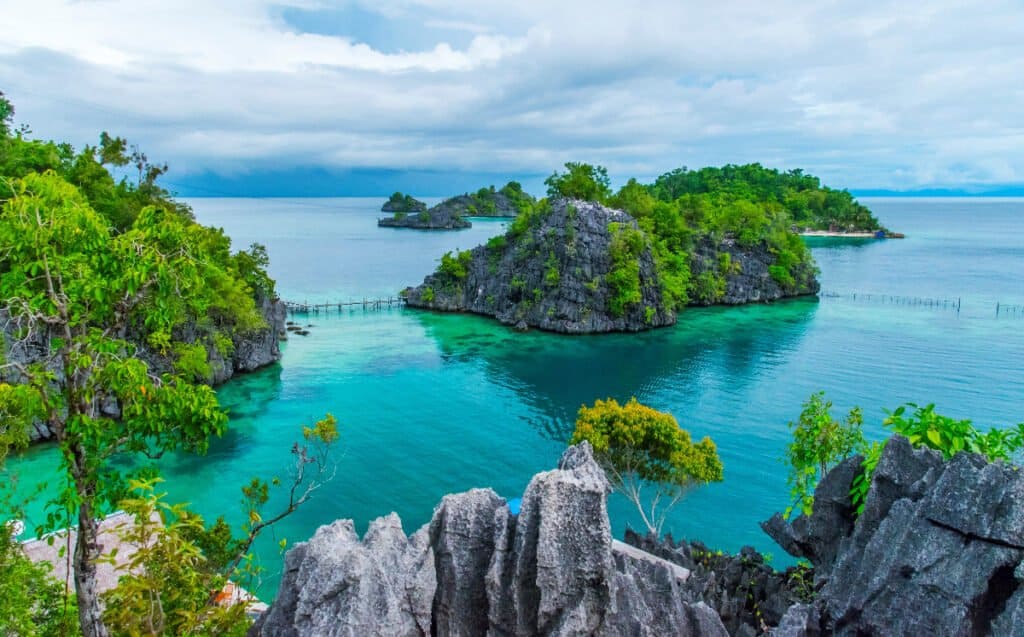
Babirusas can be found on Sulawesi and other islands in Indonesia.
©krisbiantoandy/Shutterstock.com
Diet
These animals are omnivores. Oftentimes, they use their hooves to dig in the ground in search of insects or larvae. They can stand on their back hooves supporting their body in order to eat leaves off the lower branches of a tree.
These animals eat a diet of plants, leaves, fruit, berries, insects, tree bark, and sometimes carrion. They eat fruit and berries off the ground. They dig for insects and pull bark off trees. If they find a dead animal (carrion) on the ground, they may eat it. It all depends on what food source is most plentiful in their swampy habitat at the time.
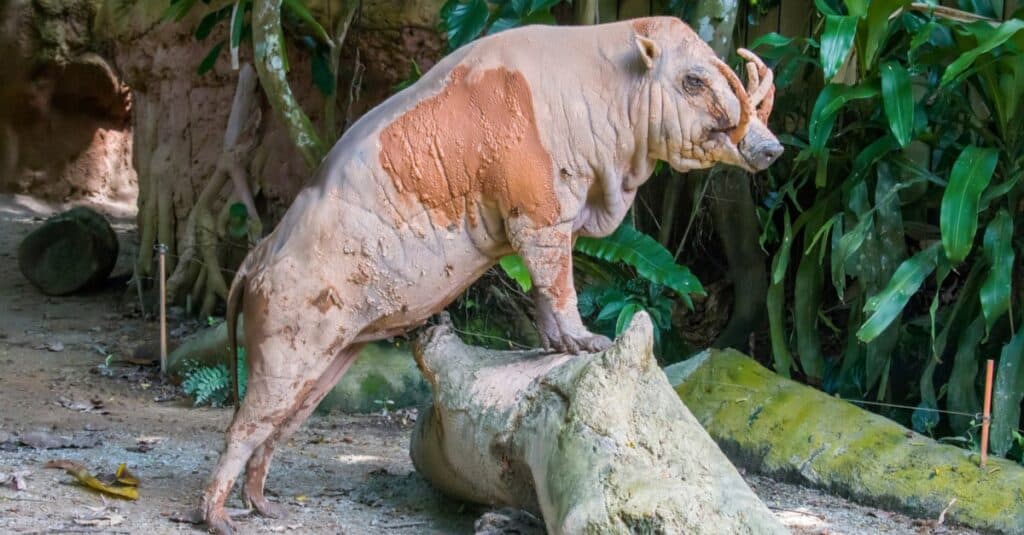
A male buru babirusa shows how it can stand on its back hooves to reach leaves.
©Danny Ye/Shutterstock.com
Predators and Threats
The animal’s only predators are humans and sometimes feral dogs. Some Indonesians hunt for babirusas in order to eat them.
The future of this mammal is at risk due to habitat loss as a result of logging activity. Poaching is another threat to these animals despite the existence of laws protecting them. Some locals even capture young babirusas and tame them to keep them as pets!
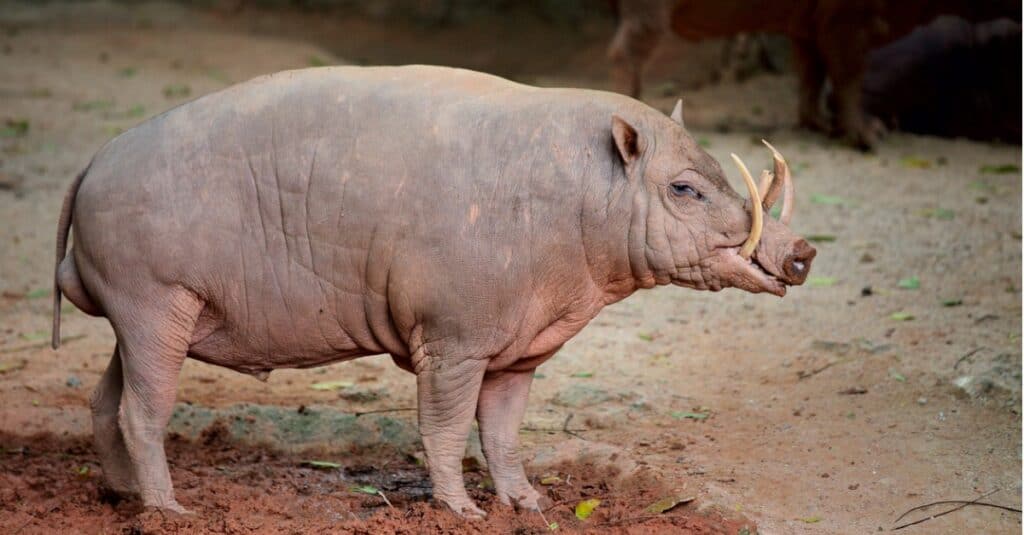
Humans are the main threat to the babirusa.
©iStock.com/leungchopan
Reproduction, Babies, and Lifespan
The mating season of the babirusa is from January to August. Males fight one another in competition for females. It would seem logical that the males would use their upper and lower tusks as weapons when fighting for a female. But, in reality, their tusks are easily cracked and broken. Some scientists believe that the curved tusks on the upper part of the snout serve to protect the animal’s eyes during this competition for females. In fact, they will purposely move their heads to the side while they are fighting so their tusks won’t smack together. So, males use their pointed hooves and the overall strength of their bodies to fight in order to determine the strongest male. The most powerful male mates with several females.
The gestation period is 155 to 158 days. A wild boar, another member of the Suidae family, has a shorter gestation period of 115 days. Females give live birth to one to two babies in a litter. Each newborn baby, aka a piglet, weighs from 10 to 15 pounds. Some babies as young as three to ten days old start to eat solid foods. However, they will likely continue to nurse until they are completely weaned at six to eight months of age. Once they are weaned, they become independent.
A babirusa’s tusks continue to grow throughout its life. This is similar to the way a person’s fingernails grow throughout life. Sometimes the tusks on a male babirusa’s upper snout continue to grow and curve until one or both break through the top of the animal’s skull! This can eventually lead to death depending on how deeply the tusk goes into the animal’s skull.
Though these animals can live up to 10 years in the wild, they have been known to live up to 24 years in captivity.

Babirusa piglets are weaned at 6-8 months.
©slowmotiongli/Shutterstock.com
Population and Conservation
According to the IUCN Redlist, the population of the Sulawesi babirusa is 9,999 mature individuals. Their population is decreasing, and they are listed with a conservation status of Vulnerable.
The population of the Togian Islands babirusa includes 1,000 mature individuals. They have a decreasing population as well and are listed as Endangered.
The population of the hairy babirusa (scientific name Babyrousa babyrussa) is unknown. This species of babirusa is listed as Vulnerable with a decreasing population.
View all 285 animals that start with BBabirusa FAQs (Frequently Asked Questions)
What is a babirusa?
A babirusa is sometimes called a deer-pig. This is because they have the appearance of a swine or pig, along with tusks that have been compared to the antlers of a deer. They live in the swamps and rainforests on islands in Indonesia namely Togian, Sulawesi, Buru, and Sula. Their most well-known feature is their tusks. A male has tusks growing up and out of its upper and lower snout. A female has tusks on the lower half of her snout. The tusks continue to grow throughout their life.
Are babirusa carnivores, herbivores or omnivores?
Babirusas are omnivores eating a diet of insects, plants, berries, fruit, insect larvae, and sometimes carrion.
Can a babirusa kill itself?
Unfortunately, this does happen. The tusks on the upper half of a male babirusa’s snout grow up and curve back toward its eyes and the top of its head. Sometimes, an older babirusa will have upper tusks that are so long, they break through the top of this animal’s skull. This ingrown tusk eventually causes death. Keep in mind the babirusa would have to be very old to have tusks long enough to penetrate its skull.
How many babirusas are left in the world?
Looking at the Sulawesi babirusa, there are 9,999 mature individuals left in the world. Their numbers are decreasing due to poaching and habitat loss as a result of logging activity. Their conservation status is Vulnerable.
The population of Togian Islands babirusas stands at about 1,000. This species of babirusa is categorized as Endangered.
How long do babirusas live?
Babirusas live about 10 years in the wild. However, they can live up to 24 years in captivity in a zoo or wildlife preserve.
How many babies does a babirusa have?
These swine have 1 to 2 babies in a litter. Females with babirusa piglets form social groups numbering up to more than 80. This group behavior provides protection for each baby babirusa as well as the adult females.
Where are babirusas found?
Babirusas live on Indonesian islands of Togian, Sula, Sulawesi, and Buru. Wild babirusas don’t live anywhere else in the world. However, there are babirusas living in zoos in various countries throughout the world.
What plants does a babirusa eat?
They eat grasses, leaves, palm plants, fungi, berries, and fruit. They also tear the bark off trees to eat it.
Thank you for reading! Have some feedback for us? Contact the AZ Animals editorial team.
Sources
- Wikipedia, Available here: https://en.wikipedia.org/wiki/Babirusa
- Saint Louis Zoo, Available here: https://www.stlzoo.org/animals/abouttheanimals/mammals/hoofedmammals/babirusa
- Cool Green Science, Available here: https://blog.nature.org/science/2014/02/11/babirusa-conserving-the-bizarre-pig-of-the-sulawesi-forest/
- Houston Zoo, Available here: https://www.houstonzoo.org/blog/national-pig-day1/

